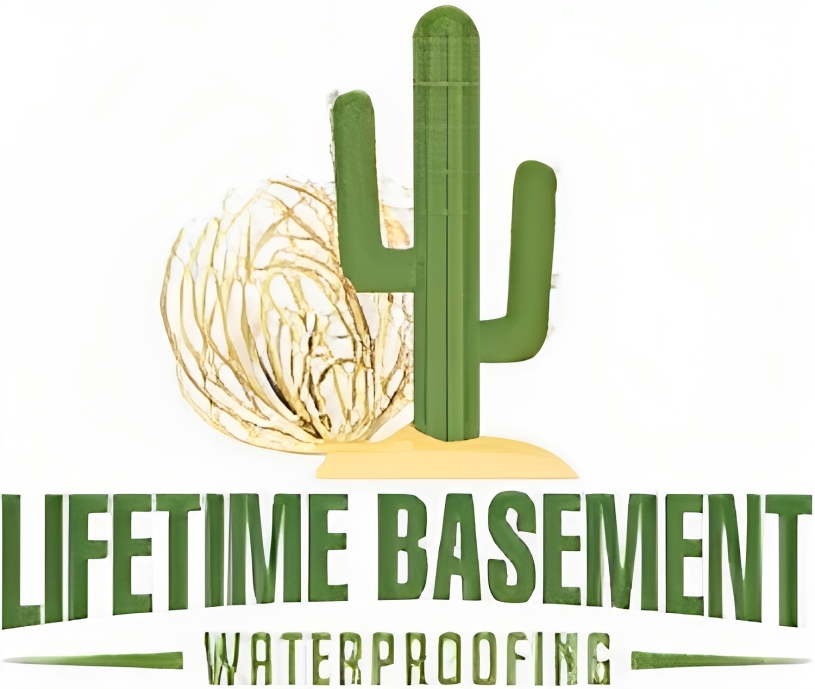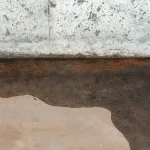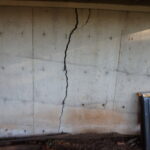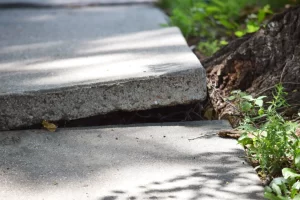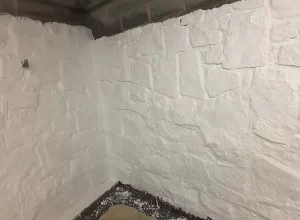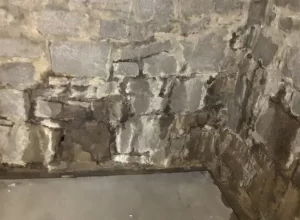
Uncover the shocking clues that may signal foundation damage in older homes. Look for horizontal and vertical cracks, stair-step cracks, bulging walls, and deteriorating mortar or bricks. Pay attention to misaligned doors, sticking windows, and basement cracks wider than a quarter inch. Keep an eye out for sloping ground, pooling water, and structural red flags like sagging beams. Understanding these signs can protect your home’s stability and value.
Key Takeaways
- Look for horizontal, vertical, and stair-step cracks in foundation walls.
- Inspect for bulging or bowing walls as signs of foundation damage.
- Check for cracked mortar, displaced bricks, and water stains on the exterior.
- Note misaligned doors, sticking windows, and cracks near openings indoors.
- Watch for wide cracks, bowing walls, water intrusion, and uneven floors in the basement.
Common Signs of Foundation Cracks
If you notice horizontal cracks along your foundation walls, it may indicate potential foundation damage in your older home. These cracks, often caused by soil pressure or water damage, can signify significant underlying issues that need prompt attention. While vertical cracks are typically less severe and commonly found in many homes due to natural settling, horizontal cracks are more critical.
In your quest to identify foundation damage, pay close attention to any stair-step cracks in your masonry or concrete blocks. These diagonal cracks, resembling a flight of stairs, are a red flag for structural problems. They can occur due to shifting soil beneath your foundation, causing parts of the wall to move independently. If left unaddressed, these cracks can lead to significant structural instability.
Another important sign to watch for is bulging or bowing walls. If you notice your foundation walls curving outward or inward, it indicates excessive pressure pushing against them. This pressure can come from various sources such as expansive soil, poor drainage, or tree roots. Ignoring these signs can result in further damage and potential collapse of your home’s foundation.
Exterior Clues: Brick and Mortar
When examining your older home for foundation damage, pay attention to the condition of the brick and mortar on the exterior walls. The exterior clues provided by the brick and mortar can offer significant insights into the health of your home’s foundation. Cracked or deteriorating mortar between the bricks can indicate foundation movement or settling issues. Look for gaps between the bricks or mortar that appear wider at the top than at the bottom, as this can suggest a foundation problem.
Additionally, keep an eye out for bricks that are cracked, chipped, or displaced. These issues may signal that the foundation has shifted, causing stress on the exterior walls. Bulging or bowed brick walls are another red flag that shouldn’t be ignored. These deformities can be a result of foundation settlement or expansive soil putting pressure on the walls.
Water stains running down the brick walls could also be a sign of foundation trouble. Excess water accumulation due to poor drainage or plumbing leaks can lead to foundation damage over time. Addressing these issues promptly can help prevent further deterioration of your home’s foundation. Regularly inspecting the brick and mortar on your home’s exterior can help you catch foundation problems early and save you from costly repairs down the line.
Interior Indicators: Doors and Windows
Inspect the doors and windows inside your older home to identify potential foundation issues. Start by checking for any signs of misalignment or sticking.
- Doors: Look for doors that no longer open or close properly. If you notice doors that jam or stick, it could indicate a shift in the foundation that has caused the door frame to become skewed. Pay attention to doors that swing open or closed on their own, as this could be a sign of a sloping floor due to foundation problems.
- Windows: Check if your windows are sticking or if they no longer open and close smoothly. Difficulty in operating windows might suggest a foundation settlement issue that has caused the window frame to become distorted. Look for gaps or cracks around the window frames, as these could indicate a shift in the foundation that’s affecting the alignment of the windows.
- Visible Gaps: Inspect the spaces around your doors and windows. If you notice sudden gaps between the frames and the walls, it could be a clue that the foundation has shifted, causing the structures to move out of alignment.
- Cracks: Examine the walls near your doors and windows for any new cracks. Vertical or diagonal cracks around these areas might signal foundation movement, especially if they’re accompanied by other symptoms like sticking doors or windows.
Warning Signs in the Basement
Examine the basement for warning signs that may indicate foundation issues in your older home. The basement can provide valuable clues about the health of your home’s foundation. Look out for cracks in the walls or floors, especially if they’re wider than a quarter of an inch. These cracks may indicate that the foundation is shifting or settling unevenly. Keep an eye on any bowing or leaning walls, as this could be a sign of pressure from the outside soil against the foundation.
Pay attention to any water intrusion or dampness in the basement. Puddles, water stains, or a musty smell could suggest poor drainage around the foundation or cracks that are allowing water to seep in. Additionally, look for any signs of rust or white powder (efflorescence) on concrete walls, as these can be indicators of water damage.
Inspect the basement for any uneven floors or sloping surfaces. If you notice that the basement floor isn’t level or has a noticeable slope, it might be a sign of foundation settlement. Keep an eye out for gaps between the basement walls and the ceiling or gaps between the walls and the floor, as these could also be signs of foundation issues.
Landscaping Clues: Soil Shifting
Keep an eye out for any noticeable changes in the landscaping around your older home, as soil shifting can provide important clues about the condition of the foundation. Here are some key signs to watch for:
- Sloping or Uneven Ground: If you notice areas where the ground is sloping or uneven, it could indicate that the soil underneath has shifted. This kind of movement can put pressure on the foundation walls and potentially lead to cracks or other issues.
- Pooling Water: Areas where water pools or stands after rain could be a sign of poor drainage caused by soil shifting. Excess moisture around the foundation can weaken it over time and contribute to foundation damage.
- Visible Cracks in the Soil: Cracks in the soil near the foundation, especially if they’re large or deep, may be a sign of soil movement. These cracks can allow water to seep into the ground and affect the stability of the foundation.
- Separation Between the House and Landscaping Features: Keep an eye on any separation or gaps that develop between the house and features like patios, walkways, or retaining walls. These gaps could indicate that the soil beneath has shifted, potentially impacting the foundation.
Structural Red Flags: Beams and Joists
If you notice any sagging or bowing in the beams and joists of your older home, it could be a red flag indicating potential structural issues. Beams and joists play an important role in supporting the weight of your home and distributing it evenly. When these elements start to show signs of distress, it may point to underlying problems that need immediate attention.
One common issue with beams and joists is wood rot. In older homes, especially those with poor ventilation or previous water damage, wood rot can weaken the structural integrity of these essential components. Look for any soft spots, discoloration, or fungal growth on the wood, as these are all indicators of wood rot.
Another concern is improper alterations or modifications. In some older homes, previous owners may have made changes to the layout or structure without considering the impact on the beams and joists. This can lead to uneven weight distribution and structural instability over time.
Additionally, inadequate support or spacing between beams and joists can cause them to bend or sag under the weight they bear. If you notice any noticeable dips or unevenness in your floors, it could be a sign that the beams and joists are struggling to support the load.
Regularly inspecting the beams and joists in your older home can help you catch potential issues early and prevent further damage to the overall structure. If you have concerns about the integrity of these components, it’s advisable to consult with a professional contractor or structural engineer to assess the situation and recommend appropriate repairs.
Frequently Asked Questions
How Can I Prevent Foundation Damage in My Older Home?
To prevent foundation damage in your older home, start by inspecting for cracks, sloping floors, or moisture issues. Maintain proper drainage, address any water leaks promptly, and consider reinforcing the foundation if needed. Regular inspections can help catch problems early.
Are There Any Common Misconceptions About Foundation Cracks in Older Homes?
Don’t fall for the misconception that all foundation cracks in older homes spell disaster. Some minor cracks may just be due to natural settling. Always have a professional inspect to determine the severity accurately.
What Are Some Long-Term Consequences of Ignoring Foundation Damage?
Ignoring foundation damage in older homes can lead to serious long-term consequences. Issues such as structural instability, water damage, and decreased property value may arise. Addressing these problems promptly can prevent further deterioration and costly repairs.
Are There Any DIY Solutions for Minor Foundation Issues in Older Homes?
If you notice minor foundation issues in older homes, consider DIY solutions cautiously. Simple fixes like filling cracks with epoxy or adjusting drainage can help temporarily. However, for significant problems, consulting a professional is essential.
How Can I Determine if My Home’s Foundation Damage Is Covered by Insurance?
To determine if your home’s foundation damage is covered by insurance, review your policy documents or contact your insurance provider for detailed information. It’s important to understand your coverage for potential repair costs.
Conclusion
Lifetime Basement Waterproofing has been Atlanta’s premier basement waterproofing company for over 30 years.
As a family-owned and operated company, we specialize in basement waterproofing and offer a range of expert services.
Our expertise extends to crawlspace encapsulation, exterior foundation waterproofing, foundation crack repair, and implementing drainage strategies such as French drains.
When it comes to wet basement repair needs, you can trust Lifetime Basement Waterproofing for high-quality solutions.
